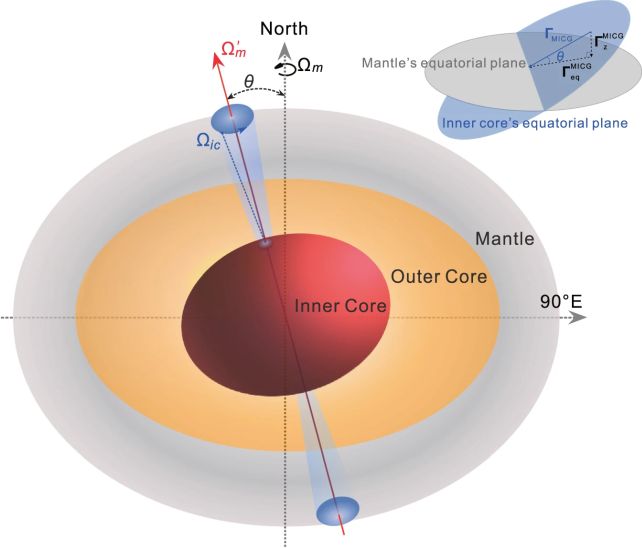
Anomalies in diverse surface measurements of the planet have unveiled periodic oscillations occurring deep within the core of the Earth.
Examining subtle variations in the Earth’s day length and pole motion, a group led by geoscientists Yachong An and Hao Ding from Wuhan University has identified a recurring 8.5-year wobble in the Earth’s inner core.
As a result, a subtle tilt of 0.17 degrees between the inner core and the mantle has been exposed, indicating an unusual density discrepancy in the northwestern hemisphere of Earth’s inner core. This peculiar observation aligns with previous indications found in seismological data.
This revelation has the potential to revolutionize our comprehension of the internal mechanisms of our planet. Certain geodynamics research previously speculated a significantly larger tilt, approximately 10 degrees; the fresh measurement provides a novel tool for deciphering surface indications of activities within the Earth’s core.
The interior of the Earth is a realm of activity that remains largely enigmatic to us. Similar to a layered structure, such as a jawbreaker or a spherical layer cake, our planet is organized. As we delve towards the core, it pulsates and convulses with molten rock and metal, growing denser and heavier the deeper one ventures.
Positioned at the heart is the core, a sphere composed of molten metal. Nestled within the core is the inner core, a compact, high-density sphere of solid iron spanning approximately 2,450 kilometers (1,520 miles) in diameter—slightly surpassing the size of Pluto.
The inner core serves as the heart of our planet in multiple dimensions. As it gradually cools and expands, it emits heat, believed to play a crucial role in significantly contributing to the dynamo that swirls within the outer core.
This fluid, which rotates, convects, and conducts, acts as the medium converting mechanical energy into magnetic energy. It is responsible for generating the magnetic field that shields our planet from radiation, atmospheric escape, and the solar wind.
Researchers are keenly intrigued by the core, the inner core, and the various peculiarities and irregularities that might impact us humans bustling about on the surface.
Given that direct measurement isn’t feasible down there, we depend on indirect measurements derived from observable phenomena at the surface.
We commonly perceive the rotation period as constant, envisioning our planet completing a full spin in precisely 23 hours, 56 minutes, and 4.0916 seconds every single day throughout the year.
Contrary to the common perception of a fixed rotation period, the planet experiences minuscule variations caused by internal shifts. A study published last year, for instance, revealed that Earth’s core changes its rotation direction approximately every six years, resulting in alterations in the length of a day.

In 2019, Ding and a team of scientists observed a distinct periodic pattern in the movement of Earth’s poles. The planet’s poles are in a state of constant and noticeable motion, influenced by various factors, leading to some peculiar behavior.
However, in 2019, Ding and colleagues identified a subtle, approximately 8.7-year motion that they believed could signify a wobbling motion within Earth’s inner core.
After this finding, An and Ding investigated alterations in Earth’s rotation that aligned with the same periodic pattern. Their efforts proved fruitful as they identified it. Through meticulous measurement of each signal, they successfully delineated the characteristics of the inner core responsible for generating these phenomena.
They discovered that the inner core is tilted by 0.17 degrees in relation to Earth’s mantle. In simpler terms, the rotational axis of the inner core and the rotational axis of the mantle are not perfectly aligned. This misalignment results in a ‘wobble’ they estimate to occur approximately every 8.5 years, as the two spheres rotate around slightly different axes.
The recorded signals also align with a more pronounced than anticipated density shift at the boundary separating the inner core and the outer core. Additionally, the inner core exhibits non-uniform density, with one hemisphere being denser than the other.
These traits might influence the dynamics of the outer core’s fluid motion and rotation, consequently contributing to the generation of Earth’s magnetic field.
Nevertheless, it appears that there is much more occurring in the core of our planet than our current understanding encompasses. With advancements in instrumentation and methodologies, our best course of action is to persist in exploring the peculiar effects that concealed activities exert on the exterior of the world.
The findings have been documented in Nature Communications.





